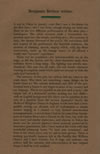
BJ. William Plomer
 |
 |
18. Curlew River: A Parable for Church Performance. Music by Benjamin Britten. London: Faber Music, 1964. Reprint, 1983. Sound recording, London: London, 1965.
Plomer’s libretto and Britten’s music combine here to constitute a work that is among the most striking incorporations of Japanese literary and dramatic form in the English tradition. Plomer and Britten had been friends since the thirties, and collaborators on several projects, and so naturally when Britten and the tenor Peter Pears planned a trip to Japan in 1956 they turned to Plomer for advice about what to see. Plomer ‘strongly recommended the Japanese theatre in its various forms, Kabuki, Bunraku, and nô’, and described a nô play, ‘enlarging upon the emotive effect of its strict stylisation, and imitating some of the formal gestures of the actors’ (22). In February Britten and Pears attended two Tokyo performances of Sumidagawa, and the effect on Britten was profound. Back in England he asked Plomer to provide a libretto for ‘an English version’. Plomer was intrigued, but knowing that the nô ‘depend[s] entirely upon its mise en scene, archaic music, all-male cast, and rigidly formal production down to the last detail of mask, costume and movement’, thought the form ‘hardly transferable to the Western operatic stage’. Britten persisted, however, and Plomer later recalled his acquiescence: ‘like the poets Yeats and Waley . . . Britten had been enchanted by the Nô, as I had been enchanted before him, so what was the good of protesting?’ (22). The result is a remarkable conjoining of traditions in the retelling of the tale of the madwoman in search of her lost son. The setting is transferred from the Kanto plain to pre-Conquest East Anglia, and the ritual overtones are Christianised, but the ritual effect itself remains, as do many of elements of the nô: the structure of the plot, the mythic setting at a holy place in the remote past, the purely symbolic use of stage properties and mask, the marriage of text, music, and stylised movement, the collaboration of performers, chorus, and orchestra, the all male cast, in its first performance the curtainless projecting stage made of natural hand-crafted wood, the opening and closing formal procession of players along a hashigakari (here a church aisle), the chorus and musical instruments at critical moments speaking for the characters, the climactic prayer culminating in a representation of union with divine presence. Neither the nô nor opera may proceed without the text, but as the text is not the opera neither is it the nô. Pound’s nô (see particularly BK24) separated for the West the nô text from the nô itself, but Plomer and Britten begin to re-sew the seam here. The first performance, in June 1964, was at the medieval Church of Orford in Suffolk, as part of the Aldeburgh Festival, with Pears as the Madwoman. See 27d and 40 for notes about Plomer and Britten’s correspondence about the work, 22 for Plomer’s public account of this correspondence, A44 for the best study of the relation between the play and the nô, 19 and 21 for other Plomer and Britten ‘church dramas’ based on the techniques developed here, and see also A39, BJ28a, 36a, 39, 41, BL253, and D23.

